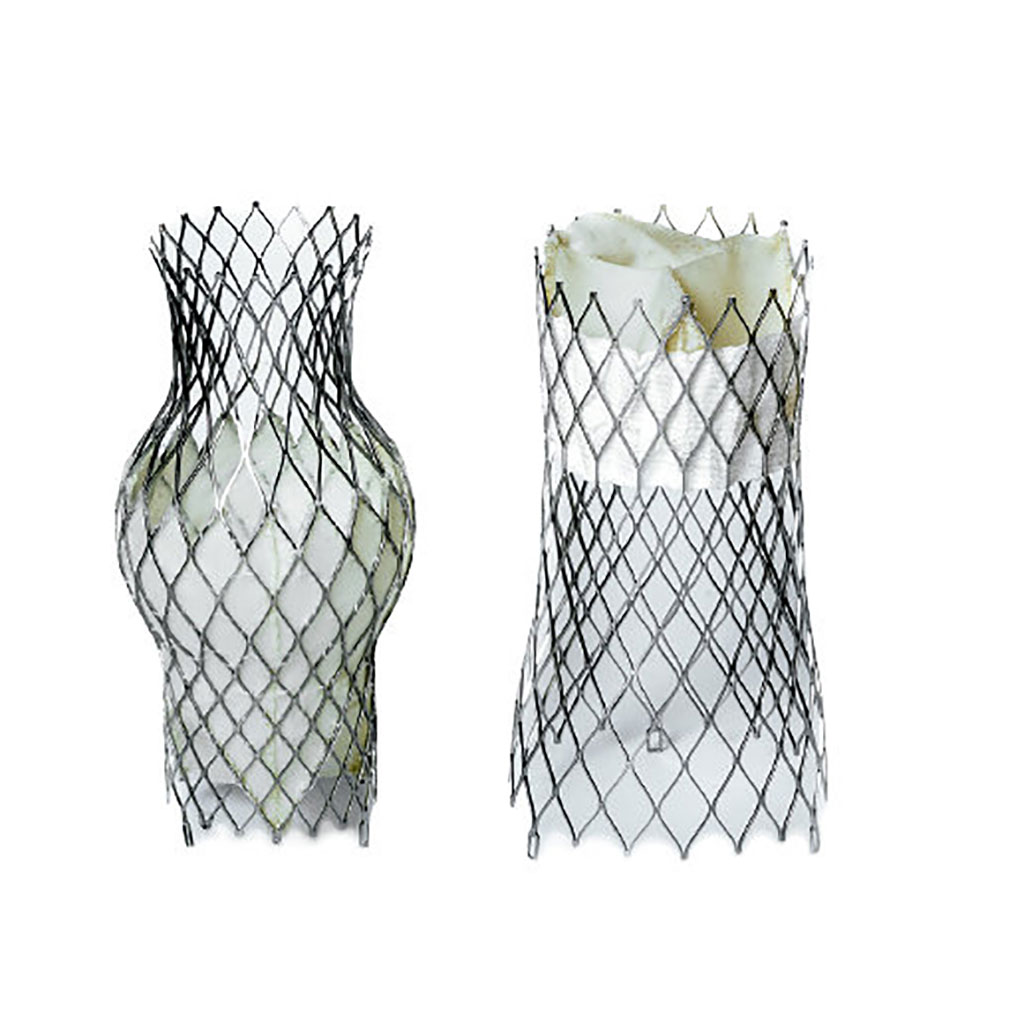Biological Valve System Treats Tricuspid Valve Disease 
|
By HospiMedica International staff writers Posted on 05 Jan 2021 |

Image: The superior (L) and inferior (R) vena cava TricValve Transcatheter Bicval valves (Photo courtesy of P+F Products + Features)
A new tricuspid regurgitation (TR) therapy system treats patients at extreme risk or who are ineligible for open surgical therapy.
The Products+Features (P+F; Vienna, Austria) TricValve Transcatheter Bicval Valves system is comprised of two self-expanding biological valves made of bovine pericardium that are designed to treat patients with hemodynamically relevant TR insufficiency and caval reflux. The valves are implanted simultaneously via a percutaneous procedure into both the superior and inferior vena cava, without disturbing the native tricuspid valve. The valves come fully pre-mounted, facilitating the use of the system in clinical practice.
The superior vena cava valve is available in sizes of 25 mm and 29 mm; the 25 mm valve encompasses a treatment range of 22-31 mm, and the 29 mm valve is intended for veins 27-34 mm in diameter. Nitinol frame heights are 67 and 69 mm respectively in a relaxed state, with a long polyethylene terephthalate (PET) skirt to prevent para valvular leak (PVL). The inferior vena cava valve is available is 31 mm and 35 mm diameters; the treatment ranges are 24-31 mm and 28-35 mm, respectively. Frame height in both inferior vena cava valves is 65 mm, including a short PET skirt to prevent hepatic vein occlusion.
“The TricValve system represents a new technology offering a potentially simple, relatively low-risk, yet effective treatment for patients with symptomatic severe tricuspid regurgitation and heart failure, many of whom harbor anatomy unfavorable for edge-to-edge repair or direct annuloplasty,” said Professor Samir Kapadia, MD, of the Cleveland Clinic (OH, USA). “It allows for all future options as patients stabilize and improve.”
The tricuspid valve separates the right atrium from the right ventricle, preventing blood from flowing from the ventricle back into the atrium. Diseases of the tricuspid valve are much rarer than those of the mitral valve, its counterpart in the left half of the heart. Tricuspid insufficiency, leading to TR, leads to build-up of blood in the ventricle and the veins, resulting in water retention in the legs and abdomen, liver damage, and potential atrial fibrillation (AF). People with TR are typically older and suffer from multiple co-morbidities, making open-heart surgery a high-risk procedure.
Related Links:
Products+Features
The Products+Features (P+F; Vienna, Austria) TricValve Transcatheter Bicval Valves system is comprised of two self-expanding biological valves made of bovine pericardium that are designed to treat patients with hemodynamically relevant TR insufficiency and caval reflux. The valves are implanted simultaneously via a percutaneous procedure into both the superior and inferior vena cava, without disturbing the native tricuspid valve. The valves come fully pre-mounted, facilitating the use of the system in clinical practice.
The superior vena cava valve is available in sizes of 25 mm and 29 mm; the 25 mm valve encompasses a treatment range of 22-31 mm, and the 29 mm valve is intended for veins 27-34 mm in diameter. Nitinol frame heights are 67 and 69 mm respectively in a relaxed state, with a long polyethylene terephthalate (PET) skirt to prevent para valvular leak (PVL). The inferior vena cava valve is available is 31 mm and 35 mm diameters; the treatment ranges are 24-31 mm and 28-35 mm, respectively. Frame height in both inferior vena cava valves is 65 mm, including a short PET skirt to prevent hepatic vein occlusion.
“The TricValve system represents a new technology offering a potentially simple, relatively low-risk, yet effective treatment for patients with symptomatic severe tricuspid regurgitation and heart failure, many of whom harbor anatomy unfavorable for edge-to-edge repair or direct annuloplasty,” said Professor Samir Kapadia, MD, of the Cleveland Clinic (OH, USA). “It allows for all future options as patients stabilize and improve.”
The tricuspid valve separates the right atrium from the right ventricle, preventing blood from flowing from the ventricle back into the atrium. Diseases of the tricuspid valve are much rarer than those of the mitral valve, its counterpart in the left half of the heart. Tricuspid insufficiency, leading to TR, leads to build-up of blood in the ventricle and the veins, resulting in water retention in the legs and abdomen, liver damage, and potential atrial fibrillation (AF). People with TR are typically older and suffer from multiple co-morbidities, making open-heart surgery a high-risk procedure.
Related Links:
Products+Features
Latest Surgical Techniques News
- DNA Origami Improves Imaging of Dense Pancreatic Tissue for Cancer Detection and Treatment
- Pioneering Sutureless Coronary Bypass Technology to Eliminate Open-Chest Procedures
- Intravascular Imaging for Guiding Stent Implantation Ensures Safer Stenting Procedures
- World's First AI Surgical Guidance Platform Allows Surgeons to Measure Success in Real-Time
- AI-Generated Synthetic Scarred Hearts Aid Atrial Fibrillation Treatment
- New Class of Bioadhesives to Connect Human Tissues to Long-Term Medical Implants
- New Transcatheter Valve Found Safe and Effective for Treating Aortic Regurgitation
- Minimally Invasive Valve Repair Reduces Hospitalizations in Severe Tricuspid Regurgitation Patients
- Tiny Robotic Tools Powered by Magnetic Fields to Enable Minimally Invasive Brain Surgery
- Magnetic Tweezers Make Robotic Surgery Safer and More Precise
- AI-Powered Surgical Planning Tool Improves Pre-Op Planning
- Novel Sensing System Restores Missing Sense of Touch in Minimally Invasive Surgery
- Headset-Based AR Navigation System Improves EVD Placement
- Higher Electrode Density Improves Epilepsy Surgery by Pinpointing Where Seizures Begin
- Open-Source Tool Optimizes Placement of Visual Brain Implants
- Easy-To-Apply Gel Could Prevent Formation of Post-Surgical Abdominal Adhesions
Channels
Critical Care
view channel
Smart Bandage Monitors Chronic Wounds in Human Patients
A future smart bandage, envisioned as a "lab on skin," could assist both patients and caregivers by not only monitoring chronic wounds but also delivering treatment and accelerating the healing process... Read more
AI Identifies Patients with Increased Lung Cancer Risk Up To 4 Months Earlier
Earlier diagnosis plays a crucial role in improving the prognosis of cancer, as delays in starting therapy are associated with decreased survival rates. In most cases, cancer is first identified when symptoms... Read more
AI Algorithm Identifies High-Risk Heart Patients
Hypertrophic cardiomyopathy (HCM) is a complex condition characterized by the thickening of the heart muscle, which impairs the heart's ability to pump blood effectively. This forces the heart to work... Read more
Next Gen Hemodynamic Monitoring Solution Provides AI-Driven Clinical Decision Support
A new cutting-edge hemodynamic monitoring platform, equipped with predictive artificial intelligence (AI)-based algorithms, is designed to help clinicians proactively manage blood pressure fluctuations... Read morePatient Care
view channel
Portable Biosensor Platform to Reduce Hospital-Acquired Infections
Approximately 4 million patients in the European Union acquire healthcare-associated infections (HAIs) or nosocomial infections each year, with around 37,000 deaths directly resulting from these infections,... Read moreFirst-Of-Its-Kind Portable Germicidal Light Technology Disinfects High-Touch Clinical Surfaces in Seconds
Reducing healthcare-acquired infections (HAIs) remains a pressing issue within global healthcare systems. In the United States alone, 1.7 million patients contract HAIs annually, leading to approximately... Read more
Surgical Capacity Optimization Solution Helps Hospitals Boost OR Utilization
An innovative solution has the capability to transform surgical capacity utilization by targeting the root cause of surgical block time inefficiencies. Fujitsu Limited’s (Tokyo, Japan) Surgical Capacity... Read more
Game-Changing Innovation in Surgical Instrument Sterilization Significantly Improves OR Throughput
A groundbreaking innovation enables hospitals to significantly improve instrument processing time and throughput in operating rooms (ORs) and sterile processing departments. Turbett Surgical, Inc.... Read moreHealth IT
view channel
Printable Molecule-Selective Nanoparticles Enable Mass Production of Wearable Biosensors
The future of medicine is likely to focus on the personalization of healthcare—understanding exactly what an individual requires and delivering the appropriate combination of nutrients, metabolites, and... Read more
Smartwatches Could Detect Congestive Heart Failure
Diagnosing congestive heart failure (CHF) typically requires expensive and time-consuming imaging techniques like echocardiography, also known as cardiac ultrasound. Previously, detecting CHF by analyzing... Read moreBusiness
view channel
Expanded Collaboration to Transform OR Technology Through AI and Automation
The expansion of an existing collaboration between three leading companies aims to develop artificial intelligence (AI)-driven solutions for smart operating rooms with sophisticated monitoring and automation.... Read more















